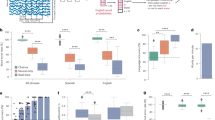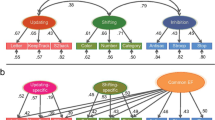Abstract
As a basic indicator of verbal ability, verbal fluency refers to the degree of fluency in the use of language to convey information. The different components of working memory play an important role in verbal fluency. The inhibiting control mechanism takes place during L2 production processing in bilinguals, which may affect their verbal fluency and distinguish them from native speakers. The participants of our study were 90 Tibetan–Chinese bilinguals and 30 native Chinese speakers. The study attempts to investigate the verbal fluency and cognitive mechanism of bilinguals’ L2. The present study’s results found L2 verbal fluency in Tibetan–Chinese bilinguals is significantly lower than that of native Chinese speakers. L2 verbal fluency has changed under the influence of their mother tongue, mainly manifested as its semantic fluency of L2 relying not only on the visuospatial sketchpad but also the phonological loop. Moreover, the processing of bilinguals’ L2 is influenced by the processing mode of L1 in the verbal fluency task.

Similar content being viewed by others
References
Acheson, D. J., & Mac Donald, M. C. (2009). Verbal working memory and language production: Common approaches to the serial ordering of verbal information. Psychological Bulletin, 135(1), 50.
Baddeley, A. D. (1986). Working memory. New York: Oxford University Press.
Baddeley, A. D., & Hitch, G. J. (1974). Working memory. In G. A. Bower (Eds.), Recent advances in learning and motivation (pp. 74–90). New York: Academic Press.
Baddeley, A. D., Lewis, V. J., Eldridge, M., & Thomson, N. (1984). Attention and retrieval from long-term memory. Journal of Experimental Psychology: General, 113, 518–540.
Bai, X. J., Zhou, S., Liu, Y., Yang, H. B., & Wang, C. (2016). Language-specific cortical activation patterns for phoneme verbal fluency task in Chinese assessed by functional near-infrared spectroscopy. Journal of Psychological Science, 39(3), 520–526.
Bosshardt, H. G., Ballmer, W., & De Nil, L. F. (2002). Effects of category and rhyme decisionson sentence production. Journal of Speech Language Hear Research, 45(5), 844–857.
Chang, S., Wang, R. M., Li, L., & Xie, J. S. (2013). Activation of non-target words during Chinese–English bilinguals’ language production. Psychological Development and Education, 29(7), 54–60.
Chen, B. G., & Xu, H. H. (2010). Influence of working memory capacity on processing English temporary syntactic ambiguity sentences for Chinese–English bilinguals. Acta Psychologica Sinica, 42(2), 185–192.
Chen, X., Nguyen, T. K., Guanglei, H., Xu, F., & Wang, Y. (2010). Effects of cross-language transfer on first-language phonological awareness and literacy skills in Chinese children receiving English instruction. Journal of Educational Psychology, 102(3), 712–728.
Collins, A. M., & Loftus, E. F. (1975). A spreading-activation theory of semantic processing. Psychological Review, 82(6), 407–429.
Colomé, A. (2001). Lexical activation in bilinguals’ speech production: Language-specific or language-independent? Journal of Memory and Language, 45(4), 721–736.
Costa, A., Miozzo, M., & Caramazza, A. (1999). Lexical selection in bilinguals: Do words in the bilingual’s two lexicons compete for selection? Journal of Memory and Language, 41, 365–397.
Costa, A., & Santesteban, M. (2004). Lexical access in bilingual speech production: Evidence from language switching in highly proficient bilinguals and L2 learners. Journal of Memory and Language, 50(4), 491–511.
Cui, M., Zhang, W. G., & Sun, T. (2018). Linguistic distance, language learners’ mother tongue, and Chinese acquisition: An empirical study from the perspective of language economics. Chinese Teaching in the World, 32(2), 280–288.
Frings, C., Schneider, K. K., & Moeller, B. (2014). Auditory distractor processing in sequential selection tasks. Psychological Research, 78(3), 411–422.
Gao, X. L., Wang, Y. S., Guo, Z. Y., Zhang, M. M., & Bai, X. J. (2015). The characteristics of semantic and lexical representation of Tibetan–Chinese bilinguals. Studies of Psychology and Behavior, 13(6), 737–743.
Gong, S. Y., & Fang, F. X. (2005). The features of lexical and conceptual representation in the second language of nonproficient Chinese–English learners. Psychological Science, 28(5), 1108–1111.
Green, D. W. (1998). Mental control of the bilingual lexico-semantic system. Bilingualism: Language and Cognition, 1, 67–81.
Groot, De. (1992). Bilingual lexical representations: A closer look at conceptual representations. In R. Frost & L. Katz (Eds.), Orthography, phonology, morphology and meaning (pp. 389–412). New York: North-Holland.
Grosjean, F. (1998). Studying bilinguals: Methodological and conceptual issues. Bilingualism: Language and Cognition, 1(2), 131–149.
Heij, La. (2005). Selection and processes in monolingual and bilingual lexical access. Oxford: Oxford University Press.
Hermans, D., Bongaeterts, T., De Bot, K., & Schreuder, R. (1998). Producing words in a foreign language: Can speakers prevent interference from their first language? Bilingualis: Language and Cognition, 1(3), 213–229.
Huang, J., Lu, A. T., & Zhang, J. J. (2011). Cross-language interference in the verbal fluency of Mandarin-Cantanese diglossia people. Psychological Research, 4(4), 32–37.
Huo, J., & Wang, Q. (2011). An empirical study of the involvement of working memory components in Chinese–English bilinguals writing output. Foreign Language Teaching and Research, 43(6), 877–886.
Jurado, M. A., Mataro, M., Verger, K., Bartumeus, F., & Junque, C. (2000). Phonemic and semantic fluencies in traumatic brain injury patients with focal frontal lesions. Brain Injury, 14(9), 789–795.
Kellogg, R. (2004). Working memory components in written sentence production. American Journal of Psychology, 117(3), 341–361.
Kellogg, R., Olive, T., & Piolat, A. (2006). Verbal, visual, and spatial working memory in written language production. Acta Psychologica, 124(3), 382–397.
Keung, Y. C., & Ho, S. H. (2009). Transfer of reading-related cognitive skills in learning to read Chinese (L1) and English (L2) among Chinese elementary school children. Contemporary Educational Psychology, 34(2), 103–112.
Leggio, M. G., Silveri, M. C., Petrosini, L., & Molinari, M. (2000). Phonological grouping is specifically affected in cerebellar patients: A verbal fluency study. Journal of Neurology, Neurosurgery and Psychiatry, 69(1), 102–106.
Li, L., Mo, L., Wang, R. M., & Luo, X. Y. (2006). The effect of cross-language repetition priming in less proficient Chinese–English bilinguals. Acta Psychologica Sinica, 38(5), 672–680.
Li, L., Mo, L., Wang, R. M., Luo, X. Y., & Chen, Z. (2009). Evidence for long-term cross-language repetition priming in low fluency Chinese-English bilinguals. Bilingualism: Language and Cognition, 12(1), 13–21.
Li, J., Wang, F. M., Hou, Y., Yang, Y. S., & Qi, S. S. (2012). The characteristics of semantic and lexical representation for less proficient Mongolia–English bilinguals. Journal of Inner Mongolia Normal University (Natural Science Edition), 41(1), 64–73.
Lu, A. T., Zhang, J. J., & Mo, L. (2008). The impact of attentional control and short-term storage on phonemic and semantic fluency. Acta Psychologica Sinica, 40(1), 25–36.
Martin, A., Wiggs, C. L., Lalonde, F., & Mack, C. (1994). Word retrieval to letter and semantic cues: A double dissociation in normal subjects using interference tasks. Neuropsychologia, 32(12), 1487–1494.
Mei, L. L., Qu, J., & Li, H. L. (2017). The cognitive and neural mechanisms of second language learning. Journal of South China Normal University (Social Science Edition), 6, 63–73.
Meng, Y. F., Lin, W. J., Lin, J. Y., & Cai, C. Q. (2016). The phonological or semantic activation of non-target language in an immediate cross-language switching paradigm. Acta Psychologica Sinica, 48(2), 121–129.
Mo, L., Li, L., & Wang, R. M. (2005). Evidence for long-term cross-language repetition priming of the highly proficient Chinese–English bilinguals. Psychological Science, 28(6), 1288–1293.
Olive, T., Kellogg, R., & Piolat, A. (2008). Verbal, visual, and spatial working memory demands during text composition. Applied Psycholinguistics, 29(4), 669–687.
Quinn, J. G., & McConnell, J. (1996). Irrelevant pictures in visual working memory. Quarterly Journal of Experimental Psychology, 49(1), 200–215.
Rende, B. (1999). The contribution of cognitive resources to performance on verbal fluency tasks (Unpublished doctoral dissertation). Boulder: University of Colorado.
Rende, B., Ramsberger, G., & Miyake, A. (2002). Commonalities and differences in the working memory components underlying letter and category fluency tasks: A dual-task investigation. Neuropsychology, 16(3), 309–321.
Riva, D., Nichelli, F., & Devoli, M. (2000). Developmental aspects of verbal fluency and confrontation naming in children. Brain and Language, 71(2), 267–284.
Rosselli, M., Ardila, A., Araujo, K., Weekes, V. A., & Araujo, K. (2000). Verbal fluency and repetition skills in healthy older Spanish–English bilinguals. Applied Neuropsychology, 7(1), 17–24.
Ruff, R. M., Light, R. H., Parker, S. B., & Levin, H. S. (1997). The psychological construct of word fluency. Brain and Language, 57(3), 394–405.
Troyer, A. K., Moscovitch, M., & Winocur, G. (1997). Clustering and switching as two components of verbal fluency: Evidence from younger and older healthy adults. Neuropsychology, 11(1), 138–146.
Wang, R. M., Deng, H. S., Li, J. J., Li, L., & Fan, M. (2011). The activation of non-attended language in language comprehension of Chinese-English bilingual. Acta Psychologica Sinica, 43(7), 771–783.
Wang, Y. P., & Li, J. L. (2016). Neural mechanisms of second language learning and potential implications for foreign language education. Journal of Bio-education, 4(4), 186–193.
Warburton, E., Wise, R. J. S., Price, C. J., Weiller, C., Hadar, U., Ramsay, S., & Frackowiak, R. J. S. (1996). Noun and verb retrieval by normal subjects: Studies with PET. Brain, 119(1), 159–179.
Yan, H. (2016). A dual mechanism model of language processing in the bilingual brain. Contemporary Linguistics, 18(4), 592–603.
Yi, B. S., & Luo, S. Q. (2012). The effect of working memory capacity on written language production of second language learners. Foreign Language Teaching and Research, 44(4), 536–546.
Zeelenberg, R., & Pecher, D. (2003). Evidence for long-term cross-language repetition priming in conceptual implicit memory tasks. Journal of Memory and Language, 49(1), 80–94.
Zhang, J. J. (2004). General psychology. Guangzhou: Guangdong High Education Press.
Zhang, J. J., & Lu, A. T. (2007). The impact of the articulary loop and visuospatial sketchpad on phonemic and semantic fluency. Acta Psychologica Sinica, 39(6), 1012–1024.
Zhu, M. M. (2018). Neural substrates of speech production: The role of domain-general cognitive functions (Unpublished master’s dissertation). Shanghai: East China Normal University.
Acknowledgements
My sincere thanks go to the students who took part in this study. I am also grateful to my classmates for their assistance in carrying out the experiment.
Funding
This work was supported by fund for building world-class universities (disciplines) of Renmin University of China (RUCPSY0014).
Author information
Authors and Affiliations
Corresponding author
Ethics declarations
Conflict of interest
The authors declare that they have no conflict of interest.
Ethical Approval
All procedures performed in this study were in accordance with the ethical standards of the Biomedical Ethics Committee of Hebei Normal University.
Informed Consent
Informed consent was obtained from all individual participants and their teachers included in the study.
Additional information
Publisher's Note
Springer Nature remains neutral with regard to jurisdictional claims in published maps and institutional affiliations.
Rights and permissions
About this article
Cite this article
Wang, J., Zhang, J. & Cui, Z. L2 Verbal Fluency and Cognitive Mechanism in Bilinguals: Evidence from Tibetan–Chinese Bilinguals. J Psycholinguist Res 50, 355–374 (2021). https://doi.org/10.1007/s10936-020-09730-7
Published:
Issue Date:
DOI: https://doi.org/10.1007/s10936-020-09730-7




